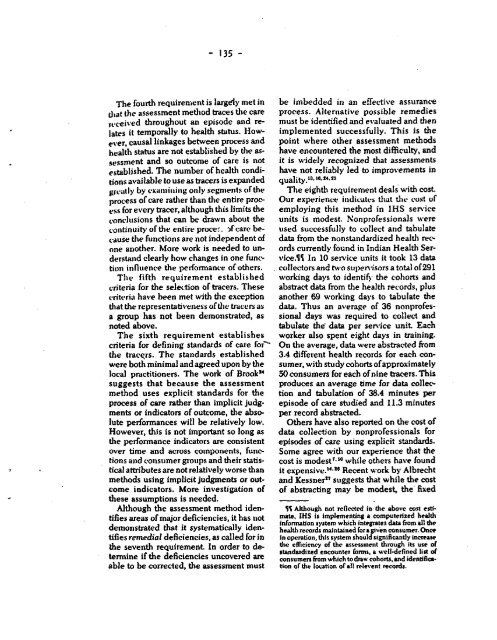BOOKS OF RtfiDIfGS - PAHO/WHO
BOOKS OF RtfiDIfGS - PAHO/WHO
BOOKS OF RtfiDIfGS - PAHO/WHO
Create successful ePaper yourself
Turn your PDF publications into a flip-book with our unique Google optimized e-Paper software.
- 135 -<br />
The fourth requirement is largely met in<br />
that the assessment method traces the care<br />
received throughout an episode and relates<br />
it temporally to health status. However,<br />
causal linkages between process and<br />
health status are not established by the assessment<br />
and so outcome of care is not<br />
established. The number of health conditions<br />
available to use as tracers is expanded<br />
greatly by examliiiting only segments of the<br />
process of care rather than the entire process<br />
for every tracer, although this limits the<br />
conclusions that can be drawn about the<br />
continuity of the entire procer. jf care because<br />
the functions are not independent of<br />
one another. More work is needed to understand<br />
clearly how changes in one function<br />
influence the performance of others.<br />
The fifth requirement established<br />
criteria for the selection of tracers. These<br />
criteria have been met with the exception<br />
that the representativeness ofithe tracers as<br />
a group has not been demonstrated, as<br />
noted above.<br />
The sixth requirement establishes<br />
criteria for defining standards of care for'"<br />
the tracers. The standards established<br />
were both minimal and agreed upon by the<br />
local practitioners. The work of Brook 24<br />
suggests that because the assessment<br />
method uses explicit standards for the<br />
process of care rather than implicit judgments<br />
or indicators of outcome, the absolute<br />
performances will be relatively low.<br />
However, this is not important so long as<br />
the performance indicators are consistent<br />
over time and across comnponents, functions<br />
and consumer groups and their statistical<br />
attributes are not relatively worse than<br />
methods using implicit judgments or outcome<br />
indicators. More investigation of<br />
these assumptions is needed.<br />
Although the assessment method identifies<br />
areas of major deficiencies, it has not<br />
demonstrated that it systematically identifies<br />
remedial deficiencies, as called for in<br />
the seventh requirement. In order to determine<br />
if the deficiencies uncovered are<br />
able to be corrected, the assessment must<br />
be imbedded in an effective assurance<br />
process. Alternative possible remedies<br />
must be identified and evaluated and then<br />
implemented successfully. This is the<br />
point where other assessment methods<br />
have encountered the most difficulty, and<br />
it is widely recognized that assessments<br />
have not reliably led to improvements in<br />
quality.' 3 . 16.S4.25<br />
The eighth requirement deals with cost.<br />
Our experience indicates that the cust of<br />
employing this method in IHS service<br />
units is modest. Nonprofessionals were<br />
used successfully to collect and tabulate<br />
data from the nonstandardized health records<br />
currently found in Indian Health Service.<br />
In 10 service units it took 13 data<br />
collectors and two supervisors a total of 291<br />
working days to identiiy the cohorts and<br />
abstract data from the health records, plus<br />
another 69 working days to tabulate the<br />
data. Thus an average of 36 nonprofessional<br />
days was required to collect and<br />
tabulate the data per service unit. Each<br />
worker also spent eight days in training.<br />
On the average, data were abstracted from<br />
3.4 different health records for each consumer,<br />
with study cohorts of approximately<br />
50 consumers for each of nine tracers. This<br />
produces an average time for data collection<br />
and tabulation of 38.4 minutes per<br />
episode of care studied and 11.3 minutes<br />
per record abstracted.<br />
Others have also reported on the cost of<br />
data collection by nonprofessionals for<br />
episodes of care using explicit standards.<br />
Some agree with our experience that the<br />
cost is modest7 ' ' 0 while others have found<br />
it expensive."'16 Recent work by Albrecht<br />
and Kessner :t suggests that while the cost<br />
of abstracting may be modest, the' fixed<br />
1 Although not reflected in the above cost estimate,<br />
IHS is implementing a computerized health<br />
information system which integrates data from all the<br />
health records maintained for a given consumer. Once<br />
in operation, this system should significantly increase<br />
the efficiency of the assessment through its use of<br />
standardized encounter forms, a well-defined list of<br />
consumers from which to draw cohorts, and identification<br />
of the location of all relevent records.

















